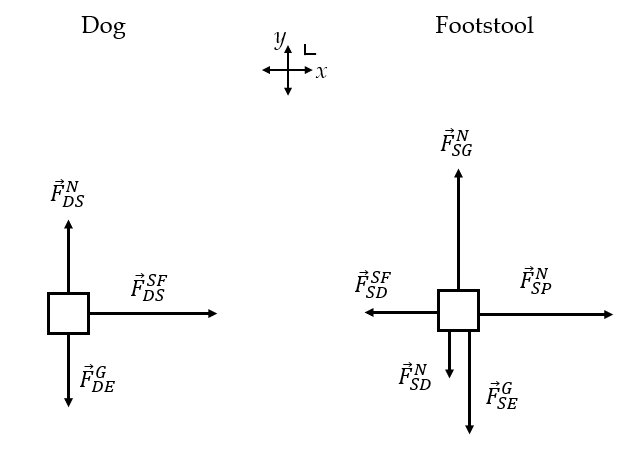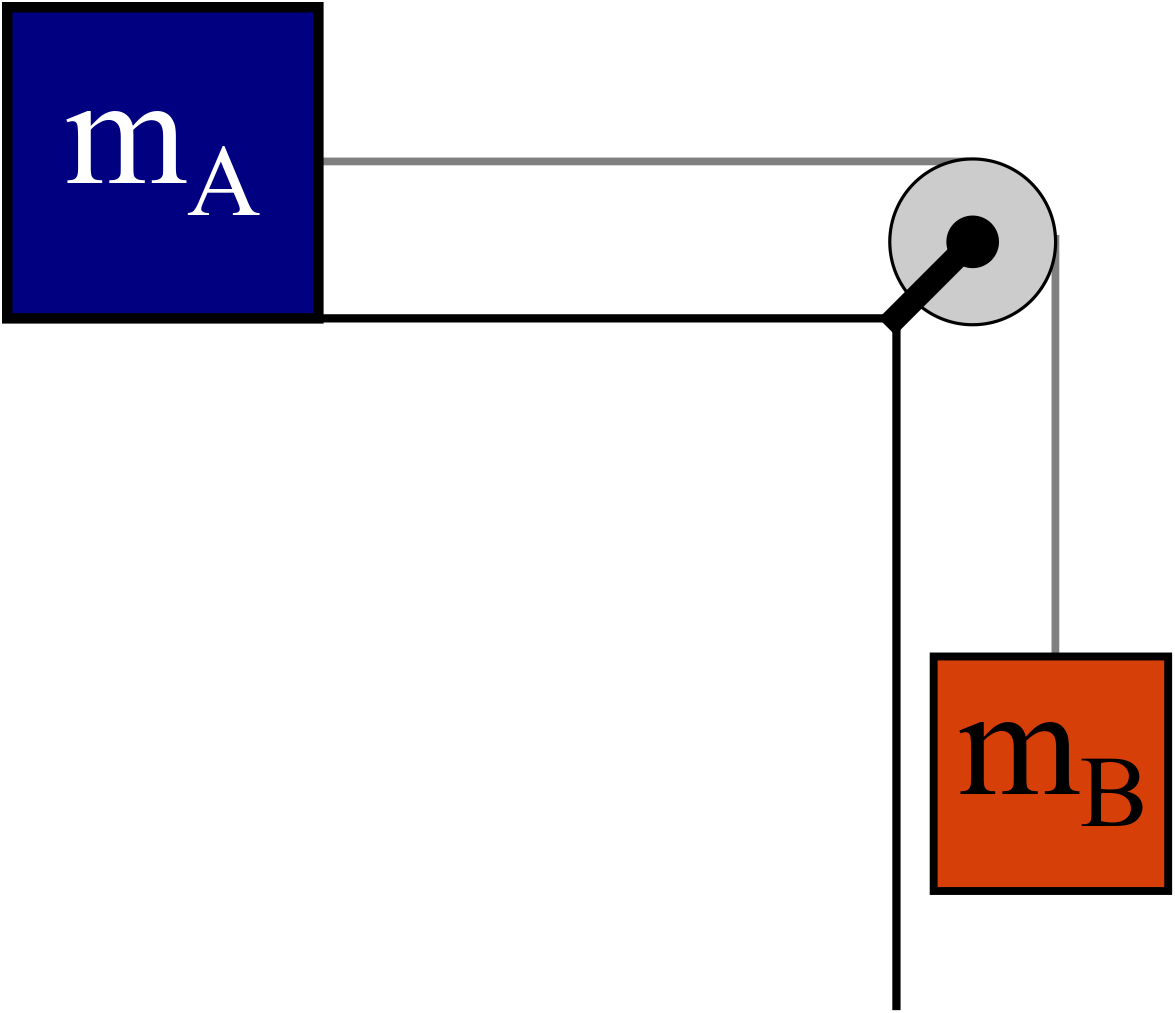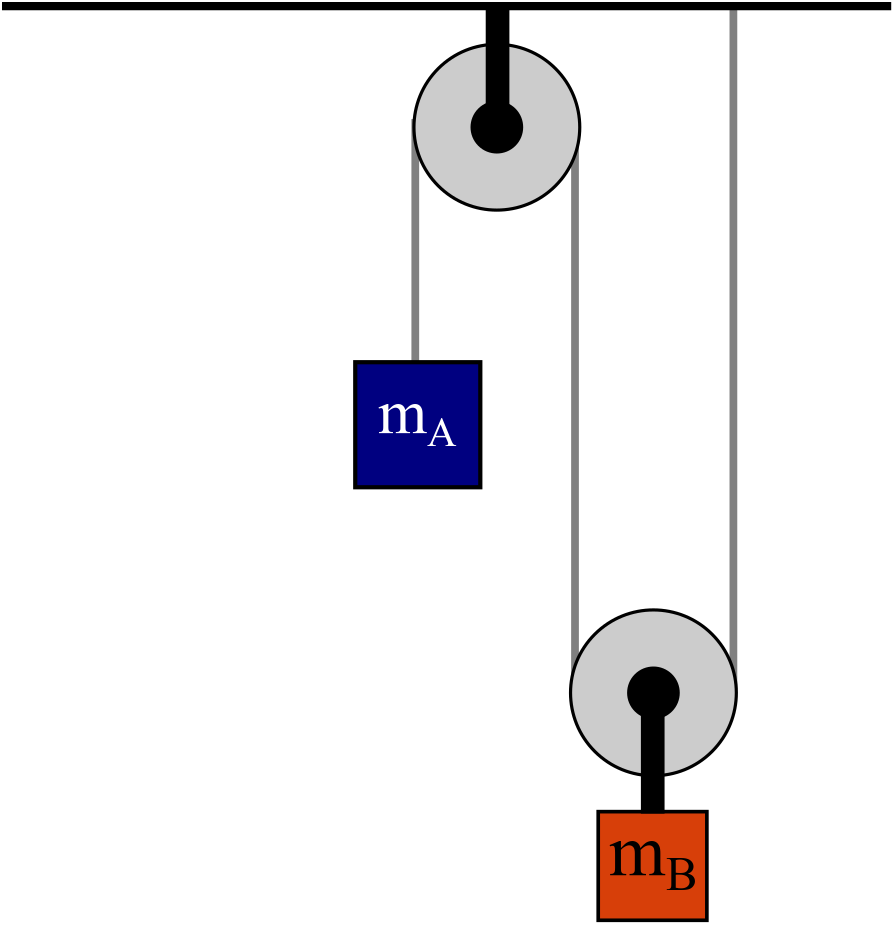Skip to main content \(\newcommand{\N}{\mathbb N}
\newcommand{\Z}{\mathbb Z}
\newcommand{\Q}{\mathbb Q}
\newcommand{\R}{\mathbb R}
\newcommand{\lt}{<}
\newcommand{\gt}{>}
\newcommand{\amp}{&}
\definecolor{fillinmathshade}{gray}{0.9}
\newcommand{\fillinmath}[1]{\mathchoice{\colorbox{fillinmathshade}{$\displaystyle \phantom{\,#1\,}$}}{\colorbox{fillinmathshade}{$\textstyle \phantom{\,#1\,}$}}{\colorbox{fillinmathshade}{$\scriptstyle \phantom{\,#1\,}$}}{\colorbox{fillinmathshade}{$\scriptscriptstyle\phantom{\,#1\,}$}}}
\)
Section 5.5 Using Action-Reaction Pairs
Exercises Practice Activities
Activity 5.5.1 . The Book Stack.
A stack of two books is at rest on a table.
Figure 5.5.1. A stack of two books. Use
Force Analysis to identify all Action-Reaction (Newton’s 3rd Law) Pairs and identify any forces that are equal in magnitude.
Activity 5.5.2 . A*R*C*S: Uh-Oh Dr. Paws.
The instructor pushes a footstool (mass
\(m_1\) ) across the floor with a constant force so that the footstool speeds up. Dr. Paws (a dog with mass
\(m_2\) ) is sitting on the footstool. The coefficient of static friction between the dog and footstool is
\(\mu\) (assume no friction with the ground).
Figure 5.5.2. A simplified sketch of a dog on a footstool.
(a) 1. Analyze and Represent.
In the example that follows, describe why the assumptions are reasonable, identify all Action-Reaction (Newton’s 3rd Law) Pairs, and identify and fix the problems with the free-body diagrams.
Mass of the footstool:
\(m_1 = 10 \mathrm{~kg}\)
Mass of the dog:
\(m_2 = 30 \mathrm{~kg}\)
Coefficient of static friction:
\(\mu = 0.4\)
Instructor force:
\(F_i = ?\)
Near-earth:
\(g = 10 \mathrm{~m/s^2}\text{;}\) particle-model; neglect air-resistance; no friction with the ground.
Represent the situation physically.
Figure 5.5.3. Two free-body diagrams.
(b) 3. Sensemake.
You have three friends who each calculate a different equation for the maximum allowable force the instructor can apply:
\begin{equation*}
F_{SP}^N = \mu \frac{𝑚_1}{𝑚_1 + 𝑚_2}g
\end{equation*}
\begin{equation*}
F_{SP}^N = \mu\left( 𝑚_2 - 𝑚_1 \right)g
\end{equation*}
\begin{equation*}
F_{SP}^N = \mu \frac{𝑚_1 𝑚_2}{(𝑚_1 + 𝑚_2}g
\end{equation*}
Use a sensemaking strategy to give a reason why each expression is incorrect .
(c) 2. Calculate.
Represent physics principles that will help you solve for the tension and the acceleration.
Determine a symbolic equation for each unknown quantity in terms of known variables.
Plug numbers into your symbolic answer.
Activity 5.5.3 . The Block Race.
Block A is accelerated across a frictionless table by a hanging
\(10 \mathrm{~N}\) mass. An identical block B is accelerated by a constant
\(10 \mathrm{~N}\) tension in the string.
Figure 5.5.4. Two Blocks connected to strings.
(a) Before you begin, predict which block you think will have a larger acceleration.
(b) Use
Force Analysis to determine the acceleration of each block. Sketching free-body diagrams for each object is essential!
Activity 5.5.4 . The Pair of Blocks.
Blocks A and B are connected by an ideal string via a massless pulley. The coefficient of kinetic friction is
\(\mu\text{.}\)
Figure 5.5.5. Two Blocks connected by a string over a pulley. Use the
A*R*C*S Steps to determine the acceleration of each block.
This situation is a particularly good one for special-case analysis: what are some cases you might want to try?
Activity 5.5.5 . The Pair of Pulleys.
Blocks A and B are connected by an ideal string via two massless pulleys.
Figure 5.5.6. Two Blocks connected by a string to two pulleys. Use the
A*R*C*S Steps to determine the acceleration of each block.
Tip .
The magnitudes of the block’s accelerations are different. How can you relate them?






